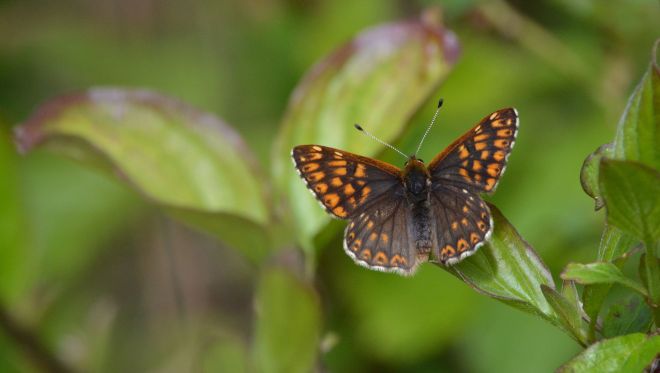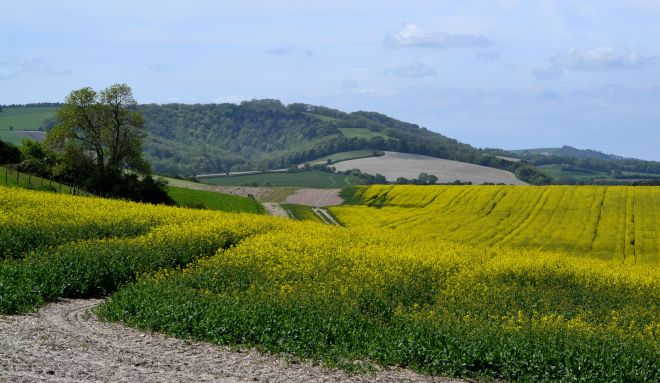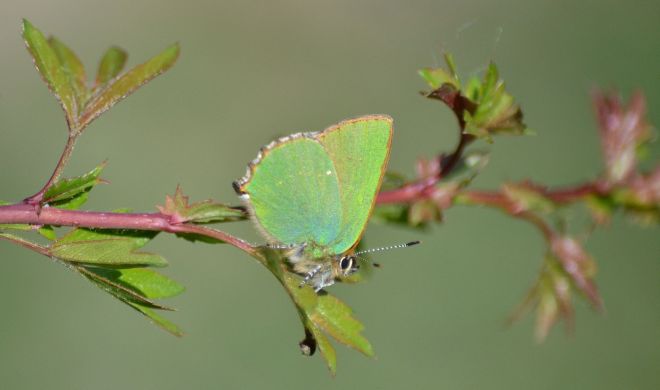This butterfly (pictured below) is probably my Duke of the 2018 season. Why so? Because it was self-found in a new and rather stunning location, then kept still for long enough for me to practice with camera settings and get things passably right. The last of those reasons was helped by there not being another human soul around.

Basking Duke of Burgundy (male), a scarce and diminutive jewel
This all began while I researched some Sussex butterfly sites on Wednesday morning (9th). In the absence of new and different southern English butterflies to experience, I have considered visiting more locations beyond Oxon, Bucks and Berks as a motivation in 2018. Now, reading of Heyshott Down on the South Downs escarpment it seemed so scenic and otherwise superb I just upped and went.
I was not disappointed on arrival. The South Downs national park is not an area I know well, but its outstanding natural beauty has always impressed when travelling nearby. The Duke site (SU896168) is reached via a minor road east of Cocking on the A286 and towards the village of Heyshott itself. The picture below is the view back from where I chose to park.

The South Downs escarpment between Cocking and Heyshott
From below the butterfly habitat was immediately apparent a little further to the east. Access tracks leading up to it through arable fields were populated with the new season’s fresh Orange Tip and Green-veined White, flying amongst upward thrusting Cow Parsley, abundant English Bluebells and other wild flowers. Eventually I reached a gate into open access land that resembled the historically quarried habitat of Noar Hill. This had to be the place and up and onward I climbed.
As previously at Noar Hill and Rake Bottom (see previous post) I found just two territorial male Duke of Burgundy in this third spot, though more were no doubt present had I searched thoroughly enough. With the second of these tiny jewels I sat down for a while and enjoyed the sense of communion that is only possible when completely alone with a self-discovered insect in a beautiful natural ambience. Such a situation banishes at least temporarily all thoughts of material and populist concerns or any other of the assorted stresses of daily existence.
The location I had reached was an equal part of the experience: remote, wild, perfectly quiet and unspoiled at least on this occasion by dog walkers, kite flyers, mountain bikers, shouters and whoopers, projectile throwers, light aircraft performing aerobatics or any of the other man-made distractions that butterflying can entail. Aside possibly of their imbalance of oilseed rape fields, the vistas northward into The Weald (below) could perhaps be described as the acme of traditional English summer. I simply luxuriated in having all this rural peace and tranquillity to myself in the spirit quenching sunshine of such an early May day.
On Thursday (10th) I had arranged to go butterflying with Ewan, our first such outing in 2018. As he had not observed Duke of Burgundy in a while we went first to Noar Hill, Hants (SU745317) which was a re-visit for me but a first for him. This time the Dukes were at last out in force and we began to find them as soon as we entered the hill-top Hants and IoW Trust reserve. During two hours on site we must have amassed 25-30 butterflies between us, and aside of one group outing and a conservation work party we had the place quite agreeably to ourselves for much of the time.
These (below) are my better new images from this visit, armed as I was with a preferred camera setting from the previous day. Once located this is quite an easy butterfly to approach since the territorial males tend to return to the same spot over and again if disturbed or after flying up to challenge rivals. On this breezy day they were distributed in more sheltered spots in the many former medieval chalk pits across this hill top.
Most of the Dukes I have recorded this May have been in such a pose, males absorbing warmth on exposed perches. It seems they have been less inclined to offer underwing images in the current season. But more importantly, a threatened species appears to be faring tolerably well in the southern counties and carefully managed habitats of the visits described here.
One thing that always strikes me about this butterfly is just how small they are. Given the high regard they excite amongst enthusiasts due to their scarcity, I had expected something a bit bigger when I first went out on Butterfly Conservation field meetings in 2010. But then as now their diminutiveness was in inverse proportion to their reputation. The species was once known as Duke of Burgundy Fritillary on account of the colouration. But this is not a fritillary at all, rather the sole European member of a butterfly family occurring in other parts of the world.
In amongst the abundant Cowslip on which Noar Hill’s DoB depend, the sward here was becoming carpeted in Orchids (pictured above). It is always a pleasure to include some pictures of these iconic wild plants in a blog post. I am not a botanist but believe these are Early Purple Orchid or hybrids thereof.
So now I have done justice to Duke of Burgundy in their present flight season. Earlier this week on 8th I also went out locally to record one of my favourite butterflies, the subtle and delicate Green Hairstreak. During an earlier visit to the Chilterns escarpment on 22nd April (see here) I had noticed the Hawthorn scrub habitat at the species’ former stronghold of Linky Down (SU725965) was growing up once more, having been cut severely by English Nature in recent seasons. So now I went back to see whether butterfly numbers were on the increase again. In the event I found two specimens, one of which sat up for the camera nicely (pictured below).

The heart gladdening treasure that is Green Hairstreak
A three minute scene for a forthcoming TV production was being filmed on the hillside above the M40 motorway, a day long exercise that seemingly required a vast assemblage of vehicles, facilities, equipment and people. When the luvvies saw someone with camera and binoculars walking close to their cordoned off area, they sent their EN contact across to find out what I was doing. It was perhaps an effort of understanding for the one-off visitors, being so far from London that a person carrying optics on a national nature reserve might just be observing wildlife rather than looking at themselves.
So having been engaged by someone from English Nature I took the opportunity to talk to him about the site’s butterflies and habitat management. Whilst saying that Dingy Skipper are still present on another part of the reserve, he confirmed as when I last encountered an EN work party here that the Hawthorn scrub will be cut again soon. The priority is to preserve the chalk downland sward and hence to remove the invasive Hawthorn. I dare say there are very sound reasons for this but to my mind it is still a shame that one of Oxfordshire’s best Green Hairstreak locations was destroyed in the process.















